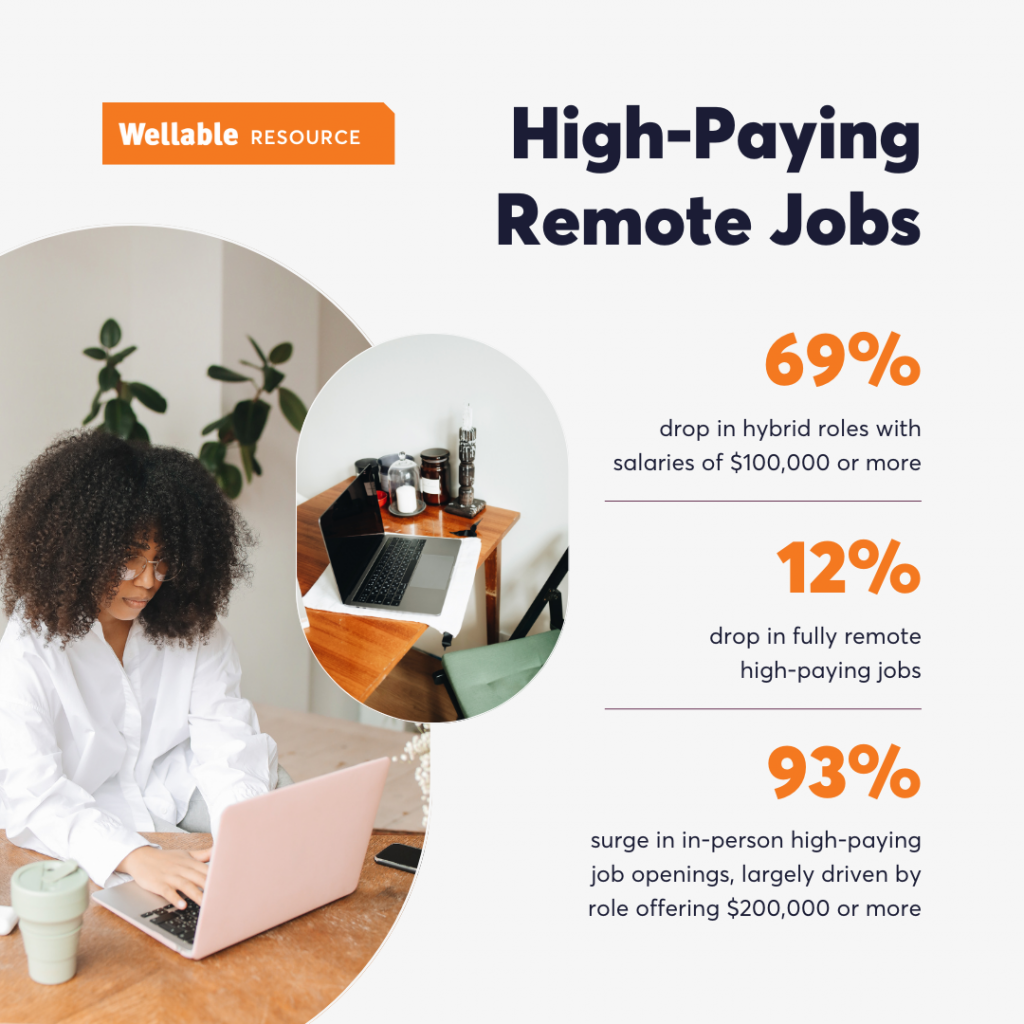Following an era of booming flexible work opportunities, the job market is seeing a significant drop in high-paying remote and hybrid positions. Meanwhile, there’s an increased demand among employees for roles that not only promise better compensation but redefine workplace flexibility and job satisfaction.

These shifts are reshaping how employers and workers view employment, salaries, and the balance between remote and in-office work.
Pressed for time? Here’s a quick summary…
- Flexible role scarcity: High-paying hybrid and remote roles declined sharply in late 2023 while high-paying in-person jobs surged by 93%.
- Rethinking retention: Beyond competitive salaries, organizations should offer benefits like career development opportunities, childcare support, and increased work flexibility to retain talent.
- Culture evolution: A return-to-office (RTO) mandate can damage a company culture built on trust and autonomy. To maintain these aspects, employers must ensure team-building events are optional, encourage regular time off, and embrace empathy towards personal circumstances that may interfere with RTO policies.
- Supporting work-life balance: Organizations with a mandated RTO can offer schedule flexibility and subsidized commuting, childcare, and meal expenses to support employees in the transition.
Scarcity Of High-Paying Remote & Hybrid Jobs
Recent findings from Business Insider reveal a diminishing availability of high-paying remote and hybrid jobs:
- Hybrid roles with salaries of $100,000 or more dropped by 69% in the last quarter of 2023
- Fully remote high-paying jobs fell by 12% in the same period
- In-person job availability surged by 93%, largely driven by roles offering $200,000 or more
This data reflects employers’ preference for having their highest earners in-office to foster collaboration and leadership.

Potential Impacts
As the availability of high-paying flexible roles declines, companies face the challenge of maintaining employee retention and company culture.

Retention Challenges
Organizations must go beyond salaries to retain their best employees. With the rise in on-site, high-paying opportunities, companies must diversify their retention strategies, which can include:
- Career development opportunities and mentorship programs to promote professional growth
- Sabbaticals for more experienced employees focusing on personal projects or family responsibilities
- Subsidized or on-site childcare for working parents
- Wellness benefits and flexible work arrangements to demonstrate a commitment to employees’ health and work-life balance

Culture Evolution
The belief that returning to the office inherently strengthens company culture by encouraging direct interactions is misleading. It overlooks the role of flexibility in promoting inclusivity, satisfaction, and engagement. Imposing an RTO policy can spark resentment, damaging a culture built on trust, empathy, and autonomy.
Organizations must adopt strategies that cultivate an empathetic and supportive work environment, regardless of the setting:
- Optional team-building events: Organizing games or team challenges can foster camaraderie, collaboration, and connection. However, these activities should be voluntary to respect employees’ autonomy, as mandatory fun could exacerbate any resentment from mandated RTO policies.
- Encourage time off: Regardless of a company’s PTO policy, managers and leadership should promote guilt-free time off, ensuring employees can take much-needed rest without work-related pressure.
- Empathetic leadership: Embrace empathy towards employees’ unique needs, allowing for flexibility within blanket RTO policies when personal circumstances interfere. This understanding deepens trust and loyalty.

Work-Life Balance
If some form of in-office work is essential, employees might need to readjust their personal and professional priorities. Organizations can support this transition by providing:

- Flexible work arrangements: This could include options such as:
- Freeform hybrid model: Set a number of required days at the office while allowing employees to choose their in-office days.
- Flextime: Offer employees the freedom to select their work hours.
- Condensed workweek: Introduce options for reduced workweeks by shaving off low-value tasks and unnecessary meetings.
- Lifestyle spending accounts (LSAs): LSAs empower employees to allocate funds to wellness and lifestyle expenses of their choice, supporting activities outside of work.
- Subsidized RTO costs: Help ease the financial burden of returning to the office by covering expenses like:
- Commuting
- Childcare
- In-office meals












